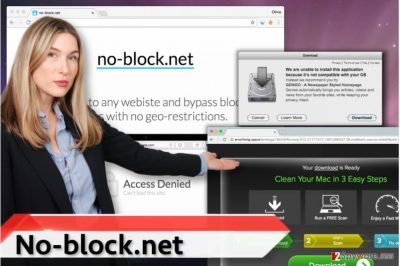No-block.net ads (Free Instructions) - Tutorial
No-block.net ads Removal Guide
What is No-block.net ads?
No-block.net ads – are they dangerous?
No-block.net virus is a clone of no-stops.net virus. This computer parasite alters browser’s settings and then starts displaying various third-party offers during user’s browsing sessions, sadly, annoyance might be the least problematic thing considering other issues that might arise from No-block.net ads. Although the program advertises itself as a proxy server[1] that helps to access geo-restricted websites and blocked services, it is clear that the author of this tool had entirely different intentions when developing it. Instead of helping the user to access restricted websites, it simply bombards the user with third-party ads collected from various ad networks. It is advisable to refrain from exploring these offers because clicking on them can cause redirects to highly suspicious or even dangerous third-party sites[2]. Once on such sites, you can be easily convinced to install a program you don’t need or sign up and provide personal information[3], and this can pose a threat to your privacy.

If you are a security-minded PC user, better take actions to protect yourself from dangerous content online, and avoid clicking on eye-catching offers that pop-up on your screen out of thin air. Remember the good old rule – if it looks too good to be true, it is. Therefore, if you do not want to be lured into insecure third-party websites, better stay away from No-block.net ads and remove No-block.net components from your PC. For that, we highly recommend using anti-spyware software like FortectIntego. You can also try to fix affected browsers manually (please see No-block.net removal tutorial, which is given right below the article).
How did I install a program without even realizing it?
You could get this ad-supported parasite either by installing a suspicious program or by following setup instructions provided on No-block.net website. No-block.net might come into your system in the form of a program or a browser extension, but it can come in like a fileless infection and simply alter your proxy settings[4] without installing anything on your computer. We suggest you carefully inspect suggested settings when installing free programs because, with a help of software bundling method, free programs typically help various potentially unwanted programs to reach computer systems effectively. We suggest choosing Custom/Advanced settings in software installers, as this is the easiest way to notice and deselect suggestions to install third-party software, browser toolbars[5] and other meaningless components that can add no value to your computer.
How to remove No-block.net?
If you were forced to change your proxy settings without realizing it, wait no longer and remove No-block.net virus using anti-malware software. We also prepared a manual No-block.net removal tutorial, which explains how you should eliminate it manually. Do not hesitate and contact us if you need any extra help when trying to remove No-block.net from your PC.
You may remove virus damage with a help of FortectIntego. SpyHunter 5Combo Cleaner and Malwarebytes are recommended to detect potentially unwanted programs and viruses with all their files and registry entries that are related to them.
Getting rid of No-block.net ads. Follow these steps
Uninstall from Windows
Instructions for Windows 10/8 machines:
- Enter Control Panel into Windows search box and hit Enter or click on the search result.
- Under Programs, select Uninstall a program.

- From the list, find the entry of the suspicious program.
- Right-click on the application and select Uninstall.
- If User Account Control shows up, click Yes.
- Wait till uninstallation process is complete and click OK.

If you are Windows 7/XP user, proceed with the following instructions:
- Click on Windows Start > Control Panel located on the right pane (if you are Windows XP user, click on Add/Remove Programs).
- In Control Panel, select Programs > Uninstall a program.

- Pick the unwanted application by clicking on it once.
- At the top, click Uninstall/Change.
- In the confirmation prompt, pick Yes.
- Click OK once the removal process is finished.
Delete from macOS
Remove items from Applications folder:
- From the menu bar, select Go > Applications.
- In the Applications folder, look for all related entries.
- Click on the app and drag it to Trash (or right-click and pick Move to Trash)

To fully remove an unwanted app, you need to access Application Support, LaunchAgents, and LaunchDaemons folders and delete relevant files:
- Select Go > Go to Folder.
- Enter /Library/Application Support and click Go or press Enter.
- In the Application Support folder, look for any dubious entries and then delete them.
- Now enter /Library/LaunchAgents and /Library/LaunchDaemons folders the same way and terminate all the related .plist files.

Remove from Microsoft Edge
Delete unwanted extensions from MS Edge:
- Select Menu (three horizontal dots at the top-right of the browser window) and pick Extensions.
- From the list, pick the extension and click on the Gear icon.
- Click on Uninstall at the bottom.

Clear cookies and other browser data:
- Click on the Menu (three horizontal dots at the top-right of the browser window) and select Privacy & security.
- Under Clear browsing data, pick Choose what to clear.
- Select everything (apart from passwords, although you might want to include Media licenses as well, if applicable) and click on Clear.

Restore new tab and homepage settings:
- Click the menu icon and choose Settings.
- Then find On startup section.
- Click Disable if you found any suspicious domain.
Reset MS Edge if the above steps did not work:
- Press on Ctrl + Shift + Esc to open Task Manager.
- Click on More details arrow at the bottom of the window.
- Select Details tab.
- Now scroll down and locate every entry with Microsoft Edge name in it. Right-click on each of them and select End Task to stop MS Edge from running.

If this solution failed to help you, you need to use an advanced Edge reset method. Note that you need to backup your data before proceeding.
- Find the following folder on your computer: C:\\Users\\%username%\\AppData\\Local\\Packages\\Microsoft.MicrosoftEdge_8wekyb3d8bbwe.
- Press Ctrl + A on your keyboard to select all folders.
- Right-click on them and pick Delete

- Now right-click on the Start button and pick Windows PowerShell (Admin).
- When the new window opens, copy and paste the following command, and then press Enter:
Get-AppXPackage -AllUsers -Name Microsoft.MicrosoftEdge | Foreach {Add-AppxPackage -DisableDevelopmentMode -Register “$($_.InstallLocation)\\AppXManifest.xml” -Verbose

Instructions for Chromium-based Edge
Delete extensions from MS Edge (Chromium):
- Open Edge and click select Settings > Extensions.
- Delete unwanted extensions by clicking Remove.

Clear cache and site data:
- Click on Menu and go to Settings.
- Select Privacy, search and services.
- Under Clear browsing data, pick Choose what to clear.
- Under Time range, pick All time.
- Select Clear now.

Reset Chromium-based MS Edge:
- Click on Menu and select Settings.
- On the left side, pick Reset settings.
- Select Restore settings to their default values.
- Confirm with Reset.

Remove from Mozilla Firefox (FF)
Open Firefox and type into its address bar: about:support. Select Refresh Firefox… from a panel on the right. Confirm your choice.
Remove dangerous extensions:
- Open Mozilla Firefox browser and click on the Menu (three horizontal lines at the top-right of the window).
- Select Add-ons.
- In here, select unwanted plugin and click Remove.

Reset the homepage:
- Click three horizontal lines at the top right corner to open the menu.
- Choose Options.
- Under Home options, enter your preferred site that will open every time you newly open the Mozilla Firefox.
Clear cookies and site data:
- Click Menu and pick Settings.
- Go to Privacy & Security section.
- Scroll down to locate Cookies and Site Data.
- Click on Clear Data…
- Select Cookies and Site Data, as well as Cached Web Content and press Clear.

Reset Mozilla Firefox
If clearing the browser as explained above did not help, reset Mozilla Firefox:
- Open Mozilla Firefox browser and click the Menu.
- Go to Help and then choose Troubleshooting Information.

- Under Give Firefox a tune up section, click on Refresh Firefox…
- Once the pop-up shows up, confirm the action by pressing on Refresh Firefox.

After uninstalling this potentially unwanted program (PUP) and fixing each of your web browsers, we recommend you to scan your PC system with a reputable anti-spyware. This will help you to get rid of No-block.net registry traces and will also identify related parasites or possible malware infections on your computer. For that you can use our top-rated malware remover: FortectIntego, SpyHunter 5Combo Cleaner or Malwarebytes.
How to prevent from getting adware
Access your website securely from any location
When you work on the domain, site, blog, or different project that requires constant management, content creation, or coding, you may need to connect to the server and content management service more often. The best solution for creating a tighter network could be a dedicated/fixed IP address.
If you make your IP address static and set to your device, you can connect to the CMS from any location and do not create any additional issues for the server or network manager that needs to monitor connections and activities. VPN software providers like Private Internet Access can help you with such settings and offer the option to control the online reputation and manage projects easily from any part of the world.
Recover files after data-affecting malware attacks
While much of the data can be accidentally deleted due to various reasons, malware is one of the main culprits that can cause loss of pictures, documents, videos, and other important files. More serious malware infections lead to significant data loss when your documents, system files, and images get encrypted. In particular, ransomware is is a type of malware that focuses on such functions, so your files become useless without an ability to access them.
Even though there is little to no possibility to recover after file-locking threats, some applications have features for data recovery in the system. In some cases, Data Recovery Pro can also help to recover at least some portion of your data after data-locking virus infection or general cyber infection.
- ^ What is a Proxy Server?. Webopedia. Online Tech Dictionary for IT Professionals.
- ^ Dann Albright. Which Websites Are Most Likely to Infect You with Malware?. akeUseOf. Your Guide in Modern Tech.
- ^ How to Keep Your Personal Information Secure. Federal Trade Commission. Bureau of Consumer Protection's Mandate is to Protect Consumers against Unfair, Deceptive, or Fraudulent Practices.
- ^ How to reset your Internet Explorer proxy settings. Microsoft Support pages.
- ^ Why Browser Extensions Can Be Dangerous and How to Protect Yourself. How-To Geek. For Geeks, By Geeks.

















